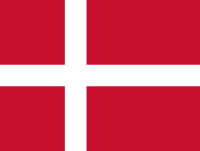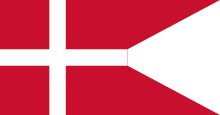Flag of Denmark
| Dannebrog | |
|---|---|
 |
|
| Vexillological symbol : |
|
| Aspect ratio: | 28:37 ( mare flag ) |
| Officially accepted: | 1625 |
The flag of Denmark is the official Danish national flag . It is called Dannebrog or Danebrog , which means flag of the Danes in Danish (from Old Norse brók , Old Danish brok , "piece of cloth, cloth").
description
The flag of Denmark shows a white cross on a red background . The two red square fields on the mast have a side length of 12 units. The white cross is 4 units wide. The two red rectangles are 12 units high and 21 units long. Together this results in a height of 12 + 4 + 12 = 28 units and a width of 12 + 4 + 21 = 37 units.
The red of the flags of the royal family and the battle flag is darker than the so-called Dannebrogsrot ( RGB -hex code E31836) and is used as Madder referred to (RGB hex code AC0234).
The pointed flag is a national emblem ; it is only used by the royal family, state institutions, the military and private individuals selected by name (here especially the yacht club ).
history

The Dannebrog is one of the oldest flags in the world. It is said that the Vikings already hoisted a red cloth that bore the name Dannebrog . The first illustration of a red flag with a white cross can be found in the Dutch Armorial Gelre book of arms from the second half of the 14th century as the field symbol of Waldemar IV. Atterdag .

According to legend, the flag of Denmark was created on June 15, 1219, when King Waldemar II fought against the pagan Estonians in the Battle of Lyndanisse - today's Tallinn . When the war seemed as good as lost, a large flag is said to have fallen from the sky and destroyed the Estonians. A connection with the imperial war flag of the Holy Roman Empire , which has been documented in the form of "silver (white) cross on a red background" since the 12th century , is assumed . Others trace it back to the flag of the Order of St. John , which in turn includes the same basic heraldic elements. Knights of this order occasionally fought in Danish armies of the Middle Ages.
The use of the sign of the cross on medieval ships, both on the top of the mast and on a cloth as a flag, is a common phenomenon of early European flagging. The Danish flag is part of a whole group of early sea marks on the North and Baltic Seas, which also include the English flag , the medieval French flag and the symbols of the knightly orders ( Johanniter , Deutscher Orden ). A ship's flag with the coat of arms of Erik VII of Pomerania with a white Dannebrog cross was hung up in 1427 and in the Marienkirche in Lübeck . The oldest known surviving Dannebrog burned there on the Palm Sunday bombing night in 1942 . The flag was first mentioned as danabroka in a Swedish source in 1439, and in 1478 for the first time in a Danish text.
On the death of King Christian VI. in 1746 a special mourning flag was used. It was a Dannebrog with its red replaced by black. It blew on Holmen for two months . In 1854 the Dannebrog was declared the national flag of Denmark. The exact proportions of the last two fields were never precisely determined. On May 1, 1893, a new instruction was issued to all police chiefs not to intervene if the proportions of the last two fields were longer than 6: 4 and did not exceed 7: 4.
The Dannebrog is also hoisted south of the German-Danish border by Danish people from southern Schleswig (next to the flag with the two Schleswig lions ). The colors of the Norwegian (red and white), the Skåne flag (red) and the flag of Greenland (red and white) are borrowed from the Dannebrog. As a Danish colony , the Virgin Islands also had the identification mark in the seal of the American Virgin Islands until 1917 . It can still be seen there.
Flag days

The following dates are the official flagging days
- January 1st: New Year
- February 5th: Crown Princess Mary's birthday
- February 6th: Princess Marie's birthday
- Good Friday ( half-mast )
- Easter Sunday
- April 9 (half-mast until 12 noon, two minutes' silence, then full-mast): Occupation of Denmark in 1940
- April 16: Birthday of Queen Margrethe II.
- April 29th: Princess Benedigte's birthday
- May 5th: Liberation of Denmark in 1945
- Ascension of Christ
- Pentecost Sunday
- May 26th: Crown Prince Frederik's birthday
- June 5: Basic Law Day ( Grundlovsdag ), signed by Frederick VII in 1849 .
- June 7th: Prince Joachim's birthday
- June 15: Waldemarstag (since 1912) and day of "reunification" ( Genforeningsdag ) 1920
- September 5th Tribute to soldiers who took part in international missions
- December 25th: Christmas Day (July Day)
In addition, everyone is free to flag as they wish. On birthdays and other family celebrations, flags are usually used, as is the case in bereavement; at half-mast until the funeral, then at full height. The Dannebrog pennant, which should be half the length of the flagpole, is used every day. It can be set when a property is occupied and remains on the pole at night.
In Denmark, private individuals are not allowed to use national flags other than those of the Nordic countries and the flags of the European Union and the United Nations . Flag collections such as in front of hotels or exhibitions are excluded. Setting a flag other than the Dannebrog requires a special permit from the Danish police. This permit can be granted if the Dannebrog is shown on its own flagpole at the same time. The Danish flag must be at least the size of the foreign flag.
variants
Flags of the royal family
Military flags
The navy flag is a little darker in color.
56: 107 ? Naval war flag (Danish orlog flag )

Historical variants
Flags of the independent parts of the kingdom
As independent parts of the Kingdom of Denmark, the Faroe Islands have officially carried their own flags since 1959 and Greenland since 1985 alongside the Danish one. Greenland's flag was deliberately designed to separate it from the cross, but the bond with Denmark shows color and basic symmetry .
2: 3 ? Greenland flag

The Danish islands of Bornholm and the Vendsyssel ( Vendelbrog ) landscape underline their regional identity with flags that are aligned with the Dannebrog.
The best-known version of the unofficial flag of Bornholm : the Bornholmer flag , which also tourists Flag (Turistflaget) is called
Unofficial flag of Vendsyssel , designed in 1976
See also
literature
German-language literature
- H. Henningsen : The Danebrog as a ship's flag. In: Alfred Kamphausen (ed.): Schleswig-Holstein and the north. Festschrift for Olaf Klose on his 65th birthday. Neumünster 1968, pp. 129-137.
- Jan Schlürmann : Between Dreifarb 'and Dannebrog. Sovereign and national symbolism as a mirror of Schleswig-Holstein identities from the 19th to the 21st century. In: Gerhard Fouquet, Mareike Hansen, Carsten Jahnke, Jan Schlürmann (eds.): From people, countries, seas. Festschrift for Thomas Riis on his 65th birthday. Tönning 2006, pp. 69-90.
Danish-language literature
- Henry Petersen: Danebroge . In: Christian Blangstrup, Jens Braage Halvorsen (ed.): Salmonsens store illustrerede Konversationsleksikon. En nordisk Encyklopædi . 1st edition. tape 4 : Canadian River – Dase . Brødrene Salmonsen, Copenhagen 1895, p. 882–885 (Danish, rosekamp.dk [PDF]).
- CL With: Danske Flag . In: Christian Blangstrup, Jens Braage Halvorsen (ed.): Salmonsens store illustrerede Konversationsleksikon. En nordisk Encyklopædi . 1st edition. tape 4 : Canadian River – Dase . Brødrene Salmonsen, Copenhagen 1895, p. 1098-1099 (Danish, rosekamp.dk [PDF]).
- Helge Bruhn: Danebrog og danske Faner called Tiderne. Copenhagen 1949 (Danish).
- Jesper Hjermind and Kristian Melgaard (editors): Om Dannebrog jeg ved… 2nd edition. Forlaget Viborg I / S, Viborg 1996, ISBN 87-90281-01-2 , p. 92 (Danish).
- Hans Christian Bjerg: Dannebrog - Historien om et Kristent and national symbol . Forlaget Hovedland, 2006, ISBN 87-7739-906-4 , p. 135 (Danish).
- Sådan bruges Dannebrog . 1st edition. Danmarks Samfundet, Brøndby 2007, ISBN 978-87-990709-0-9 , p. 65 (Danish).
Web links
- Flags of the World - Denmark (English)
- History of the national flag
- Danmarks-Samfundet (Danish association for the promotion of the spread of the Dannebrog)
Individual evidence
- ^ Ordbog over det danske Sprog . (ODS), Volume 2, 1920 ( [1] ).
- ↑ The Duden knows the spellings Danebrog and Dannebrog
- ↑ Armorial Gelre , fol. 55 BC - Cf. John Lind: Den faldt fra himlen ned. In: Skalk , 2001, No. 6, p. 23.
- ^ Bruhn: Danebrog. P. 34.
- ^ Hans Horstmann: Pre and early history of the European flag system. The legal symbols of European ships in the Middle Ages , Bremen 1971.
- ↑ In the large Swedish rhyming chronicle it says: "Hans Svena voro til Vadstena dragne med Danabroka uthslagne" (H. Henningsen: Der Danebrog als Schiffsflagge , in: Schleswig-Holstein und der Norden. Festschrift for Olaf Klose for his 65th birthday , ed. by Alfred Kamphausen, Neumünster 1968, pp. 129–137, here p. 130).
- ^ Bernt Kure: Holmen. Høst & Søn, København 2005, ISBN 87-14-29925-9 .
- ^ [2] Nordic Co-operation
- ↑ The official flagging days Ministry of Justice (Danish):
- ↑ jmarcussen.dk
- ↑ Flag regulations. (No longer available online.) In: www.spejderportal.dk. September 15, 2014, archived from the original on March 4, 2016 ; Retrieved November 4, 2015 . Info: The archive link was inserted automatically and has not yet been checked. Please check the original and archive link according to the instructions and then remove this notice.
- ↑ Udenlandske flag justitsministeriet.dk














